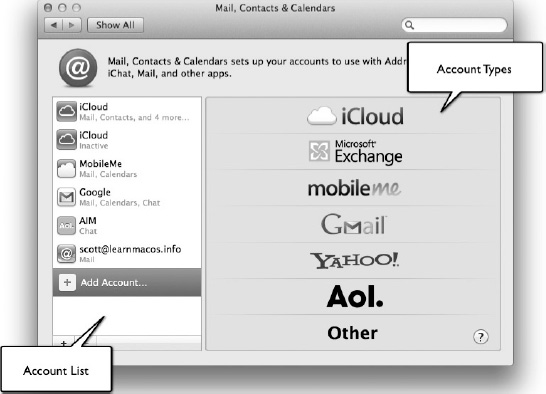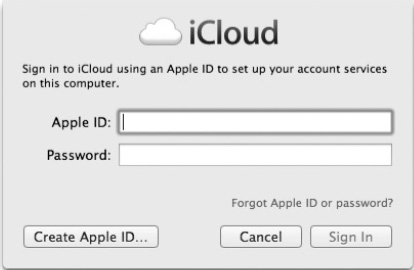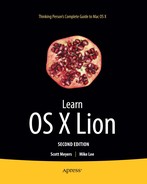Chapter 14
From MobileMe to iCloud
Leading up to Apple's WWDC (World Wide Developers Conference) in 2011, Apple announced its new iCloud service, and during WWDC Apple provided some additional information about iCloud (and MobileMe). iCloud will provide many of the features that are currently available with MobileMe. Unlike MobileMe, iCloud will be free. In this chapter you will learn
- What iCloud is and what services it provides
- How to set up your Mac to use iCloud
- Getting an
@me.come-mail address for use with iCloud - Transitioning from MobileMe to iCloud
NOTE: At the time of this writing, iCloud is not generally available, so details here are based on prerelease announcements and early beta software features. We feel that including this material here will be relevant and useful once the final version of iCloud is unveiled. Up-to-date details as they emerge will be posted at www.learnmacos.inf.
What Is iCloud
iCloud is Apple's answer to cloud computing for Mac and iOS users. It enables users to store music, photos, documents, contacts, appointments, and more “in the cloud,” and then pushes that information to any registered devices wirelessly. Most of this happens automatically without any user interaction, assuring that all of a user's up-to-date content is available across computing devices.
From the user perspective, iCloud is not really a single thing, but rather a blanket term for a number of cloud services that utilize Apple's iCloud infrastructure. Because of this there is no single iCloud application or control panel; rather, parts of iCloud are built into various system preferences and applications. Upon launch Apple has broken down the services provided by iCloud into the following features:
- iTunes in the Cloud
- Photo Stream
- Documents in the Cloud
- Apps, Books and Backup
- Mail, Contacts and Calendar
iTunes in the Cloud
There are two main services provided with iCloud's iTunes in the Cloud feature: syncing your new and existing iTunes purchases, and iTunes Match. Syncing of existing iTunes purchases is fairly straightforward: from within iTunes, click iTunes Store and select the Purchased link from the Quick Links menu. This will take you to a screen (Figure 14–1) where all of the items you've ever purchased from iTunes will be listed, allowing you to download (or redownload) the purchased items. This feature allows you to purchase an item at one location (another computer or iOS device) and download it to another without having to physically sync devices or manually transfer the purchased files.

Figure 14–1. From the Purchased view in the iTunes Store you can view and download any of your previous iTunes store purchases, no matter what computer or device you originally purchased them from.
Besides downloading past purchases from the iTunes Store, you can also have new purchases automatically downloaded by selecting the appropriate option under the Store tab in the iTunes preferences. When selected, if you purchase a song, book, or app from any other devices, it will automatically be downloaded to your computer(s).
iTunes Match
One extension to this service is an addition called iTunes Match. For $24.99 a year iTunes Match, will keep track of your iTunes library. Every song in it, no matter how it ended up in your library, will be available to download on any computer running the latest version of iTunes or any iOS 5 devices, provided that the song in question exists on the iTunes Music Store. If any song isn't available in the iTunes Music Store, the service will still work, but first you must upload any songs not already available in the iTunes Music Store (iTunes will handle all of this automatically, though).
NOTE: No matter the type or quality of the music in your original collection, the music that is downloaded from iTunes Match will be 256Kbps iTunes Plus–formatted audio files.
Photo Stream
Photo Stream is another feature of iCloud that stores and streams photographs to all your iCloud-enabled devices. On OS X, Photo Stream works primarily with iPhoto (covered in Chapter 15); however, it is possible that other applications may emerge that take advantage of this.
Photo Stream will store the last 30 days of photos in the cloud and immediately make them available to any Photo Stream–enabled software or devices. For example, a photo you take with your iPhone with iOS 5 or higher will immediately be uploaded up to iCloud's Photo Stream, where it will be immediately available in iPhoto on your Mac. The photo will remain on iCloud for 30 days, which should give you plenty of time to move it into an album if you so desire.
NOTE: A photo may appear in your stream-viewing application even after it has been removed from iCloud. For example, the Photos app on iOS 5 will store the last 1,000 photos from your stream in a rolling Photo Stream album.
CAUTION: Photo Stream is not a photo-backup feature. Your photos will be deleted from the iCloud after 30 days. You should plan on backing up any important photos elsewhere (in fact, for those special photos you may want to make two or three backups). If you wish to keep photos permanently backed up “in the cloud,” then you may want to look in to some other photo-sharing services, such as Smugmug (www.smugmug.com), Flickr (www.flickr.com), or Photobucket (www.photobucket.com)
Documents in the Cloud
Documents in the Cloud allows applications to store files on iCloud so they are available from the same app on any other device. Currently this feature is built into the latest version of iWork, so a keynote presentation you create on your Mac can be edited on your iPad and then presented from your iPhone.
NOTE: Initially, only iWork on OS X and iOS had full support for Documents in the Cloud; however, any application developer can utilize this feature from with in their application, so others are soon to follow.
Apps, Books and Backup
The Apps, Books and Backup feature is predominately geared toward iOS users. In OS X, apps and books are backed up and accessible through iTunes under the Purchased link in the iTunes store, in the same manner as iTunes-purchased music. The backup feature here is exclusively for backing up all your iOS data. This is significant in that going forward, all of your iOS data will be stored in the cloud, so while you still are able to, it will be unnecessary to sync your iOS device to a Mac or PC for updates (or for anything at all).
Mail, Contacts and Calendar
Most of the contacts, calendar, and mail features that were previously handled through MobileMe will now be handled through iCloud. These features are all set up in the Mail, Contacts & Calendars System Preference (Figure 14–2). (We will cover the details of setting up an iCloud account in the Mail, Contacts & Calendars System Preference pane later in the chapter.)

Figure 14–2. Many of the features that iCloud provides mirror features that were available in MobileMe.
Other iCloud Features
Some other features available from iCloud include Back to My Mac and Find My Mac. Back to My Mac is a feature introduced as part of MobileMe that allows you to not only share files with a remote Mac, but actually share the screen of a remote Mac as well, allowing you to work on the remote Mac from far away. (This will be covered more in Chapter 26.) Find My Mac allows you to locate your Mac if it gets lost or stolen.
HOW DOES FIND MY MAC FIND MY MAC?
NOTE: How do I know if information such as the BSSID of the Wi-Fi device I'm connected to is being sent to someone? The most direct way is to monitor your network traffic. While there are many options for doing this, Little Snitch (www.obdev.at/products/littlesnitch/index.html) is a very good option. Little Snitch can be configured to let you know whenever any application attempts to send any information over the network. It will then let you choose to let the application continue or to stop the transmission.
Setting Up iCloud on Your Mac
Before you can use iCloud, you must have an Apple ID. If you've purchased anything from the App Store or iTunes Store, then you already have one. If you have used MobileMe in the past, you can use your MobileMe e-mail address as your Apple ID. If not, you will be prompted along the way to create one.
CAUTION: As of this writing there is no way to consolidate existing Apple IDs, so if you have one, then it's probably best to use that one, and not create another. If you end up buying items using different Apple IDs, or store information under one ID and want to access it with another, you are out of luck.
Once you have your Apple ID (or have decided which one you want to use), you can activate iCloud in the Mail, Contacts & Calendars System Preference pane (shown in Figure 14–3).

Figure 14–3. When Add Account… is selected in the Mail, Contacts & Calendars System Preference pane's Account List column, a list of available account types will appear in the information area.
To begin, select the Add Account… option in the Account List column, and select iCloud from the list on the right. This will present you with a simple dialog asking you for your Apple ID and password (Figure 14–4). If you have an ID, enter the information, and an iCloud account associated with the entered Apple ID will be created.

Figure 14–4. To add an iCloud account, just enter the Apple ID and password you want to have associated with your iCloud account.
If you haven't created an Apple ID yet, select the Create Apple ID… button, and the dialog will walk you through a three-step process to create one:
- First you will be asked for your location and date of birth. This is to verify that you meet the minimum age requirements in your location (in the United States it's 13 years old).
- Next you will be asked to create your Apple ID. Here you can either use any existing e-mail address or create a new, free
@me.comiCloud e-mail address to use as your Apple ID (Figure 14–5). - Finally you must accept the terms-of-use agreement, and your iCloud account will be created.

Figure 14–5. If you don't have an Apple ID, you can create one either by using an existing e-mail account or by creating an @me.com e-mail address to use.
Once your iCloud account has been created, you can select your account from the Account list, and select some of the options you'd like to turn on for use (see Figure 14–2 again). Options include
Mail & Notes: This sets up Mail to use your
@me.come-mail address. If you used a non-@me.come-mail address as your Apple ID, you will be prompted to create an@me.come-mail address when you select this.Contacts: This will store your contacts on iCloud so they will stay in sync across devices.
Calendars: This will allow you to store calendar data on iCloud.
Bookmarks: Selecting this option will keep your Safari bookmarks synced between devices.
Photo Stream: This will enable the Photo Stream feature. To use this on your Mac you will need iPhoto 9.2 or later.
Back to My Mac: This will enable Back to My Mac for your computer. To gain full access you will need to turn on Sharing on the Sharing System Preference pane.
Find My Mac: This will enable you to locate your Mac if it is missing or has been stolen (providing it is connected to a known Wi-Fi network).
If any additional information is needed when selecting any of these options, you will be prompted for it; otherwise it should just work.
Moving from MobileMe to iCloud
With the announcement of iCloud, the fate of MobileMe became clear: going forward, it will cease to exist. Existing MobileMe users have had their MobileMe services extended to June 30, 2012, at which time the switch will be thrown and MobileMe will cease to be. In the meantime, MobileMe users will have between fall 2011, when iCloud officially launches, until that time to transition from MobileMe to iCloud. When you transition, you will be able to move your mail (including your @me.com and @mac.com e-mail addresses and aliases), contacts, calendars, and bookmarks from MobileMe to iCloud.
What we are currently unsure about, though, are other MobileMe services such as photo/file sharing, web sharing, and iDisk. It looks extremely likely that web sharing (common with iWeb users) will cease to exist. iDisk could easily be transitioned to iCloud, but details about such a move are currently unavailable. Whatever happens, MobileMe will still be around until June 2012, so it seems that there will be plenty of time to adapt.
Summary
iCloud provides transparent cloud services to OS X and iOS, which will help make the management of data and information across multiple devices seamless and effective. Additionally, it provides an infrastructure that any application can utilize to provide integrated cloud services across the OS X and iOS platforms. Some applications including iPhoto already have iCloud abilities built into them.
Next we will look at iPhoto, followed by the other two key iLife applications: iMovie and GarageBand.
